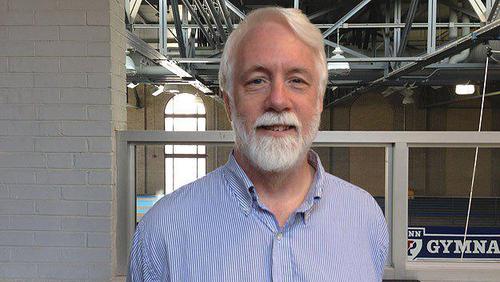Dave Johnson, the long time director of the Penn Relays, has announced his retirement. He will work in 2021 in a reduced capacity, and then devote his time to the Penn Track Library.
The piece below, we believe, is a fitting tribute to Dave Johnson, who has directed the Penn Relays since Tim Baker’s resignation in 1995. We wish Dave Johnson well. He is a good and honest man, with a wicked sense of humor and an amazing appreciation of the sport. He will be terribly missed.
Check out this piece on Dave Johnson’s announcement, then enjoy David Hunter’s salute to Dave Johnson, originally published April 29, 2016.
Dave Johnson is the director of the Penn Relays. For a track geek such as Dave Johnson, this is a dream job. This dream job, however, comes with many challenges. Here is the thoughtful piece from David Hunter on Dave Johnson, posted on the weekend of the Penn Relays, the oldest and most prestigious relay meet in America.
 Dave Johnson, photo courtesy of Hadas Kuznits (for CBS.Local Philadelphia)
Dave Johnson, photo courtesy of Hadas Kuznits (for CBS.Local Philadelphia)
122nd Penn Relay Carnival / Thursday, April 28th, 2016
Dave Johnson: Penn’s Steward
Long-Serving Director Blends Tradition With Innovation
April 28th, 2016
Franklin Field
Philadelphia, Pennsylvania
Track & Field – arguably the oldest of sports and the sport that sparked all others – places an emphasis on tradition. And no gathering pays more homage to the time-honor elements of our sport than the Penn Relays, now staging its 122nd Carnival.
But if you look more closely, over the years, Penn – quietly and without fanfare – has also found ways to integrate innovative elements in this massive 3-day meet of domestic and international high school, collegiate, and professional athletes without being disrespectful to its traditions that have evolved over 3 centuries.
Last year, after careful study and planning, the University of Pennsylvania undertook a massive renovation of the track and infield at Franklin Field. 7 years in the making, the nearly $3 million renovation was completed during 4 months in the summer on 2015 which, among other things, included a complete removal of the track surface and the installation of a top-quality Advanced Polymer Technology / Rekortan sport surface to effectuate a modest – but important – correction to eliminate a slight slope differential in the old track’s surface; a relocation of the steeplechase water jump from outside the top of the homestretch to the just inside turn 1; the creation of a 9 lane track with 6 lanes outside the 3 lanes inside the 400 meter inner rail; enhanced drainage; and new state-of-the-art jump and vault runways.
“A lot of the innovations here are not necessarily us being innovative, but are us responding to conditions, challenges, and situations that were impressed upon us,” notes Dave Johnson, the Frank Dolson Director of Penn Relays who goes on to cite the 1950 road widening of adjacent 33rd Street as an example of the challenge of adaptation to change without doing violence to the Franklin Field footprint. “We had a 220 yard straightaway back then that we ultimately knew we were going to lose. And we were already hemmed in by brick walls. Ken Doherty was the track coach at the time and he came up with the novel idea of the creating an interior track – inside the 440 yard curb. That allowed us to have more lanes on the inside. And then when we put down the synthetic track in 1966, we had 4 lanes inside the curb and 4 lanes outside the curb. And when we switched to a 400 meter configuration in 1975, we switched to 42 inch lanes and that gave us 4 lanes inside the rail and 5 all the way around the track outside the rail.” And last year’s renovation has now allowed the Franklin Field facility to offer a 9 lane track configuration.
Johnson – now in his 21st year as the Penn Relay’s Director – is quick to move beyond the smaller alterations the event has implemented over the past 122 years to focus on the pioneering step made in the 19th century that sent Penn Relays in the direction that has allowed it to become the special event it is today. “The [stages of lane growth and lane widths] have been minor, incremental changes,” states Johnson. “The main innovation has been creating a meet around the concept of relays. We didn’t start with relays here. Back then, you would see them mostly at indoor meets on the East Coast starting in the 1880’s – but usually only one of them and probably with only two teams, maybe three. In the 1890’s Penn had an annual spring handicap race and the presumed track team would dominate it. This was sort of the start of the track season and with the IC4A’s in mid-May, we were put in a really short track season. In 1893 and 1894, Penn hosted a mile relay event against Princeton. In 1895, with the growing popularity of the relay, Penn decided to start the Penn Relays – still the spring handicaps, but with about 5 collegiate match race mile relays and about 9 and prep and nigh school races. In the very first year, this new event featuring a novel format – the inaugural event held at newly-constructed Franklin Field – drew 5000 people. That was the innovation.”
The continuing success of The Penn Relay Carnival has been driven by the tradition of its leadership to never settle, to always push itself to take the event to higher and higher levels. Nearing the end of the 20th century, those surrounding the event grappled to find an effective and invigorating way to incorporate domestic and foreign professionals into the event. “A fair number of those international athletes and the U.S. national team members had been coming here anyway. But the thing was: nobody cared. There was really no rooting interest,” Johnson explains. “We had one year when the [4×400] times were 3:00; 3:01; and 3:02 – some very good races with very good athletes – and it was quiet as a mouse in there. And then you would go to the high school or college championship races and it would be rip roaring.” Could the Penn Relays develop a presentation format for the professionals that would be exciting, attractive to television, and yet sincere to the heritage of the meet? The answer: USA vs. The World – a global relay battle between nations that would provide that missing ingredient of rooting interest. “That was really a concept out of USATF and probably Craig Masback,” states the white-haired Johnson. Introduced in 2000, the formatting change for the professionals was an immediate success and continues to provide special spice to Penn’s third and final day of competition. “Putting those same athletes in national team uniforms changed the whole complexion of it,” smiles Johnson. “USATF’s idea of showing off the national team and getting it on television changed everything.”
More recently, the sport of track & field has been experimenting with new and different ways to showcase the excitement of its sport and the marvelous talents of its most gifted and accomplished athletes – seeking to find a fresh presentation approach that will inject a greater entertainment element, attract more millennials, and expand its fan base. Might NBA-like introductions, pump-up music, and fog machines be an innovative part of Penn’s future? “That’s difficult,” Johnson states cautiously. “In part because you are talking about a big block of time to do that. It’s tough to do that right in the middle of the meet. And the amount of time we already give is disruptive in terms of the flow of the meet. That’s the problem.” The Penn leader raises another point about the emerging outside-the-box ideas that are being generated in the hopes of expanding the sport’s fan base. “There are ways to do it. But the question will be: do people want to do that?” Johnson notes that smaller meets with limited events have the luxury of time to incorporate fresh, time-consuming presentation approaches. “That kind of introduction really started down in the Bahamas with the World Relay Championships. It’s much easier if you’ve only got a few events. Because if you only have a few events, you have to do something to fill time.”
Well into its third century, Penn is widely viewed as the granddaddy of the sport – a three day smorgasbord of track and field performed by all segments of its participants – high school, collegiate, and professional – from around the globe. Quite simply, it is the largest and oldest annual track and field gathering in the world. Yet Johnson, perhaps too modestly, clarifies that views on the event he has lovingly nurtured for 21 years can be varied. “It depends upon what type of track fan you are. A lot of people think it’s the best meet going. And a lot of people would pooh pooh it as just a bunch of high school stuff with some good college and pro stuff tossed in. You’ll see the whole gamut of conversation.”
Johnson is candid about what he thinks has made the Penn Relays successful. “It’s all moving pieces and you’ve got to simultaneously think on several different platforms and make certain they overlay one on top of the other and they overlay well – in space and time.” And when the elements of space and time are in proper alignment, something special happens. “One of the keys to is to put things in different parts of the stadium. As for the track races, the fans pick it up when the race hits the back stretch and that wall of sound goes all the way around for 300 meters without interruption.” And with a smile, the Director notes that it isn’t the clocking that matters – it’s the competition that makes Penn magical. “The key is the closeness of the race. The cheer follows the runners around the track. It doesn’t matter how fast or slow. If it’s close, it’s exciting.”
Even though there are no present plans developed for future leadership succession, Dave Johnson is able to reflect on his service to the Penn Relays. “I want to get out before I do something stupid,” he adds with a laugh. Turning serious, he adds, “I do have a way of looking at that. I feel I’ve taken this as far as my imagination of 20 years ago envisioned. In many ways, I’m being pulled along now. My imagination has taken me thus far. I don’t really want to be in a situation where I’m making decisions and putting us on a track where I’m not the one who will be following through on it. I want a lot more input from the people who will still be around to implement it.”
He is proud of the deliberate way Penn has embraced change. “We moved into that slowly. But it also meant that we moved into it very well. My feeling is that when we start something, I want to see a ninety percent success rate the first year. We’re known for doing things well. It’s got to work well the first time, or you’ve made a mistake.” Johnson and his team prefer to effectuate change the right way – not the hasty way. “It’s not like we have to rush into things. We’re not going away. We’re not in danger of collapse. We have time in which we can make advances. It doesn’t have to be instantaneous. But it’s nice to be in the leadership position.”
Dave Johnson continues to run with strength and courage on his leg of stewardship with the Penn Relays. He took the baton with confidence as his circuit began and during his run he has – like any good relay runner – pushed himself and taken some chances without being reckless. His carry is not over, but he knows he is on the homestretch of his service at Penn and with the knowledge that he has performed honorably and taken an event – already revered when he grabbed the stick – and respected its heritage, further burnished its reputation, adapted to changing conditions, and lifted it to a level of even higher respect. As he nears the end of his leg to ultimately pass the baton to a new generation of leadership, Johnson can be confident that he will conclude his tenure as the Director of the Penn Relays with a flourish. A review of his body of work at Penn’s helm suggests that when the time is right Dave Johnson – unlike some of our athletes on recent global championship relay squads – will be able to deliver the Penn Relays stewardship baton to his successor without incident.
Author

Dave Hunter is an award-winning journalist who is a U.S. Correspondent for Track & Field News. He also writes a weekly column and serves as Senior Writer for www.RunBlogRun.com, and covers championship track & field competition domestically and in such global capitals as Moscow, Birmingham, Zurich, Brussels, Beijing, Rio de Janeiro, Zagreb, Ostrava, and Doha. Hunter frequently serves as the arena or stadium announcer for championship track & field gatherings, including the Ivy League, the Big East, the Mid-American Conference, the NAIA, the Big Ten, and the Millrose Games. Hunter has undertaken foreign and domestic broadcast assignments. He ran his marathon P.R. 2:31:40 on the Boston Marathon course back in the Paleozoic Era. To find out more about Dave, visit his website: www.trackandfieldhunter.com He can be reached at: dave@trackandfieldhunter.com
View all posts




















